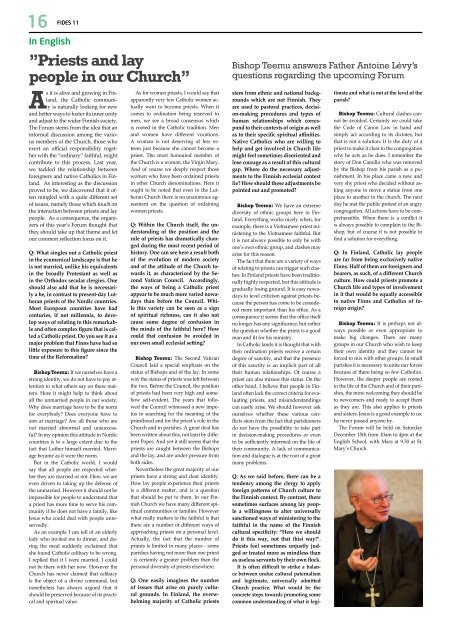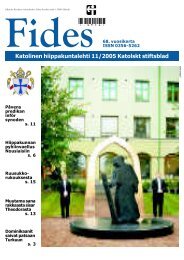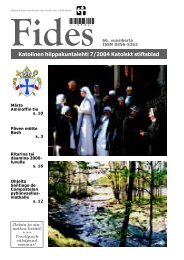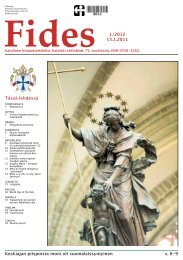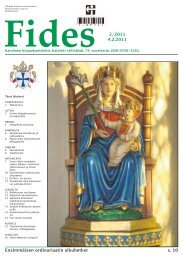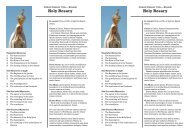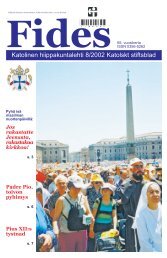Benedictus XVI ja jatkuvuuden hermeneutiikka - Katolinen kirkko ...
Benedictus XVI ja jatkuvuuden hermeneutiikka - Katolinen kirkko ...
Benedictus XVI ja jatkuvuuden hermeneutiikka - Katolinen kirkko ...
You also want an ePaper? Increase the reach of your titles
YUMPU automatically turns print PDFs into web optimized ePapers that Google loves.
16<br />
FIDES 11<br />
In English<br />
”Priests and lay<br />
people in our Church”<br />
As it is alive and growing in Finland,<br />
the Catholic community<br />
is naturally looking for new<br />
and better ways to foster its inner unity<br />
and adjust to the wider Finnish society.<br />
The Forum stems from the idea that an<br />
informal discussion among the various<br />
members of the Church, those who<br />
exert an official responsibility together<br />
with the “ordinary” faithful, might<br />
contribute to this process. Last year,<br />
we tackled the relationship between<br />
foreigners and native Catholics in Finland.<br />
As interesting as the discussion<br />
proved to be, we discovered that it often<br />
mingled with a quite different set<br />
of issues, namely those which touch on<br />
the interaction between priests and lay<br />
people. As a consequence, the organizers<br />
of this year’s Forum thought that<br />
they should take up that theme and let<br />
our common reflection focus on it.<br />
Q: What singles out a Catholic priest<br />
in the ecumenical landscape is that he<br />
is not married, unlike his equivalents<br />
in the broadly Protestant as well as<br />
in the Orthodox secular clergies. One<br />
should also add that he is necessarily<br />
a he, in contrast to present-day Lutheran<br />
priests of the Nordic countries.<br />
Most European countries have had<br />
centuries, if not millennia, to develop<br />
ways of relating to this remarkable<br />
and often complex figure that is called<br />
a Catholic priest. Do you see it as a<br />
major problem that Finns have had so<br />
little exposure to this figure since the<br />
time of the Reformation?<br />
Bishop Teemu: If we ourselves have a<br />
strong identity, we do not have to pay attention<br />
to what others say on these matters.<br />
Here it might help to think about<br />
all the unmarried people in our society.<br />
Why does marriage have to be the norm<br />
for everybody? Does everyone have to<br />
aim at marriage? Are all those who are<br />
not married abnormal and unsuccessful?<br />
In my opinion this attitude in Nordic<br />
countries is to a large extent due to the<br />
fact that Luther himself married. Marriage<br />
became as it were the norm.<br />
But in the Catholic world, I would<br />
say that all people are respected whether<br />
they are married or not. Here, we are<br />
even driven to taking up the defense of<br />
the unmarried. However it should not be<br />
impossible for people to understand that<br />
a priest has more time to serve his community<br />
if he does not have a family, like<br />
Jesus who could deal with people unreservedly.<br />
As an example I can tell of an elderly<br />
lady who invited me to dinner, and during<br />
the meal suddenly exclaimed that<br />
she found Catholic celibacy to be wrong.<br />
I replied that if I were married, I could<br />
not be there with her now. However the<br />
Church has never claimed that celibacy<br />
is the object of a divine command, but<br />
nonetheless has always argued that it<br />
should be preserved because of its practical<br />
and spiritual value.<br />
As for women priests, I would say that<br />
apparently very few Catholic women actually<br />
want to become priests. When it<br />
comes to ordination being reserved to<br />
men, we see a broad consensus which<br />
is rooted in the Catholic tradition. Men<br />
and women have different vocations.<br />
A woman is not deserving of less esteem<br />
just because she cannot become a<br />
priest. The most honoured member of<br />
the Church is a woman, the Virgin Mary.<br />
And of course we deeply respect those<br />
women who have been ordained priests<br />
in other Church denominations. Here it<br />
ought to be noted that even in the Lutheran<br />
Church there is no unanimous agreement<br />
on the question of ordaining<br />
women priests.<br />
Q: Within the Church itself, the understanding<br />
of the position and the<br />
role of priests has dramatically changed<br />
during the most recent period of<br />
history. One can see here a result both<br />
of the evolution of modern society<br />
and of the attitude of the Church towards<br />
it, as characterized by the Second<br />
Vatican Council. Accordingly,<br />
the ways of being a Catholic priest<br />
appear to be much more varied nowadays<br />
than before the Council. While<br />
this variety can be seen as a sign<br />
of spiritual richness, can it also not<br />
cause some degree of confusion in<br />
the minds of the faithful here? How<br />
could that confusion be avoided in<br />
our own small ecclesial setting?<br />
Bishop Teemu: The Second Vatican<br />
Council laid a special emphasis on the<br />
status of Bishops and of the lay. In some<br />
way the status of priests was left between<br />
the two. Before the Council, the position<br />
of priests had been very high and somehow<br />
self-evident. The years that followed<br />
the Council witnessed a new impetus<br />
in searching for the meaning of the<br />
priesthood and for the priest’s role in the<br />
Church and in parishes. A great deal has<br />
been written about this, not least by different<br />
Popes. And yet it still seems that the<br />
priests are caught between the Bishops<br />
and the lay, and are under pressure from<br />
both sides.<br />
Nevertheless the great majority of our<br />
priests have a strong and clear identity.<br />
How lay people experience their priests<br />
is a different matter, and is a question<br />
that should be put to them. In our Finnish<br />
Church we have many different spiritual<br />
communities or families. However<br />
what really matters to the faithful is that<br />
there are a number of different ways of<br />
approaching priests on a personal level.<br />
Actually, the fact that the number of<br />
priests is limited in many places - some<br />
parishes having not more than one priest<br />
- is certainly a greater problem than the<br />
personal diversity of priests elsewhere.<br />
Q: One easily imagines the number<br />
of issues that arise on purely cultural<br />
grounds. In Finland, the overwhelming<br />
majority of Catholic priests<br />
Bishop Teemu answers Father Antoine Lévy’s<br />
questions regarding the upcoming Forum<br />
stem from ethnic and national backgrounds<br />
which are not Finnish. They<br />
are used to pastoral practices, decision-making<br />
procedures and types of<br />
human relationships which correspond<br />
to their contexts of origin as well<br />
as to their specific spiritual affinities.<br />
Native Catholics who are willing to<br />
help and get involved in Church life<br />
might feel sometimes disoriented and<br />
lose courage as a result of this cultural<br />
gap. Where do the necessary adjustments<br />
to the Finnish ecclesial context<br />
lie? How should these adjustments be<br />
pointed out and promoted?<br />
Bishop Teemu: We have an extreme<br />
diversity of ethnic groups here in Finland.<br />
Everything works nicely when, for<br />
example, there is a Vietnamese priest ministering<br />
to the Vietnamese faithful. But<br />
it is not always possible to only be with<br />
one’s own ethnic group, and clashes may<br />
arise for this reason.<br />
The fact that there are a variety of ways<br />
of relating to priests can trigger such clashes.<br />
In Finland priests have been traditionally<br />
highly respected, but this attitude is<br />
gradually losing ground. It is easy nowadays<br />
to level criticism against priests because<br />
the person has come to be considered<br />
more important than his office. As a<br />
consequence it seems that the office itself<br />
no longer has any significance, but rather<br />
the question whether the priest is a good<br />
man and fit for his ministry.<br />
In Catholic lands it is thought that with<br />
their ordination priests receive a certain<br />
degree of sanctity, and that the presence<br />
of this sanctity is an implicit part of all<br />
their human relationships. Of course a<br />
priest can also misuse this status. On the<br />
other hand, I believe that people in Finland<br />
often lack the correct criteria for evaluating<br />
priests, and misunderstandings<br />
can easily arise. We should however ask<br />
ourselves whether these various conflicts<br />
stem from the fact that parishioners<br />
do not have the possibility to take part<br />
in decision-making procedures or even<br />
to be sufficiently informed on the life of<br />
their community. A lack of communication<br />
and dialogue is at the root of a great<br />
many problems.<br />
Q: As we said before, there can be a<br />
tendency among the clergy to apply<br />
foreign patterns of Church culture to<br />
the Finnish context. By contrast, there<br />
sometimes surfaces among lay people<br />
a willingness to alter universally<br />
sanctioned ways of ministering to the<br />
faithful in the name of the Finnish<br />
cultural specificity: “Here we should<br />
do it this way, not that (his) way!”.<br />
Priests feel sometimes unjustly judged<br />
or treated more as mindless than<br />
as useless servants by their own flock.<br />
It is often difficult to strike a balance<br />
between undue cultural paternalism<br />
and legitimate, universally admitted<br />
Church practice. What would be the<br />
concrete steps towards promoting some<br />
common understanding of what is legi-<br />
timate and what is not at the level of the<br />
parish?<br />
Bishop Teemu: Cultural clashes cannot<br />
be avoided. Certainly we could take<br />
the Code of Canon Law in hand and<br />
simply act according to its dictates, but<br />
that is not a solution. It is the duty of a<br />
priest to make it clear to the congregation<br />
why he acts as he does. I remember the<br />
story of Don Camillo who was removed<br />
by the Bishop from his parish as a punishment.<br />
In his place came a new and<br />
very shy priest who decided without asking<br />
anyone to move a statue from one<br />
place to another in the church. The next<br />
day he met the public protest of an angry<br />
congregation. All actions have to be comprehensible.<br />
When there is a conflict it<br />
is always possible to complain to the Bishop,<br />
but of course it is not possible to<br />
find a solution for everything.<br />
Q: In Finland, Catholic lay people<br />
are far from being exclusively native<br />
Finns. Half of them are foreigners and<br />
bearers, as such, of a different Church<br />
culture. How could priests promote a<br />
Church life and types of involvement<br />
in it that would be equally accessible<br />
to native Finns and Catholics of foreign<br />
origin?<br />
Bishop Teemu: It is perhaps not always<br />
possible or even appropriate to<br />
make big changes. There are many<br />
groups in our Church who wish to keep<br />
their own identity and they cannot be<br />
forced to mix with other groups. In small<br />
parishes it is necessary to unite our forces<br />
because of there being so few Catholics.<br />
However, the deeper people are rooted<br />
in the life of the Church and of their parishes,<br />
the more welcoming they should be<br />
to newcomers and ready to accept them<br />
as they are. This also applies to priests<br />
and sisters. Jesus is a good example to us:<br />
he never passed anyone by.<br />
The Forum will be held on Saturday<br />
December 15th from 10am to 4pm at the<br />
English School, with Mass at 9.30 at St.<br />
Mary’s Church.


